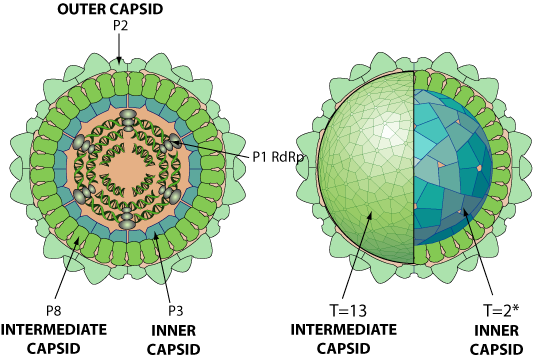VIRION

Non enveloped, icosahedral, non-turreted virion with a double capsid structure, about 70 nm in diameter. The outer capsid has a T=13 icosahedral symmetry, the inner capsid a T=2* icosahedral symmetry. Each double-layered capsid consists of 260 trimers of the major outer capsid P8 protein and 60 dimers of the inner capsid P3 protein.
GENOME
Segmented linear dsRNA genome. Contains 12 segments coding for 15 proteins. Segment 11 has two in-frame codons resulting in two ORFs. Segment 12 has two additional overlapping ORFs. Segments size range from 1066 to 4423 bp. Genome total size is about 26 kb (WTV).
GENE EXPRESSION
The dsRNA genome is never completely uncoated, to prevent activation of antiviral state by the cell in response to dsRNA. The viral polymerase synthesizes a capped mRNA from each dsRNA segment. This capped mRNA is translocated to the cell cytoplasm where it is translated. RDV expresses an additional protein by leaky scanning in the nsp12 gene.
ENZYMES
- RNA-dependent RNA polymerase [VP1]
- Cell-type capping:
- RNA TPase
- N7 MTase
- GTase
- 2'O MTase
REPLICATION
CYTOPLASMIC
- Virus penetrates into the host cell.
- Early transcription of the dsRNA genome by viral polymerase occurs inside this sub-viral particle (naked core), so that dsRNA is never exposed to the cytoplasm.
- Full-length plus-strand transcripts from each of the dsRNA segments are synthesized. These plus-strand transcripts are used as templates for translation.
- Viral proteins and genomic RNAs aggregates in cytoplasmic viral factories.
- (+)RNAs are encapsidated in a sub-viral particle, in which they are transcribed to give RNA (-) molecules with which they become base-paired to produce dsRNA genomes.
- The capsid is assembled on the sub-viral particle.
- Mature virions are released presumably following cell death and associated breakdown of host plasma membrane.


